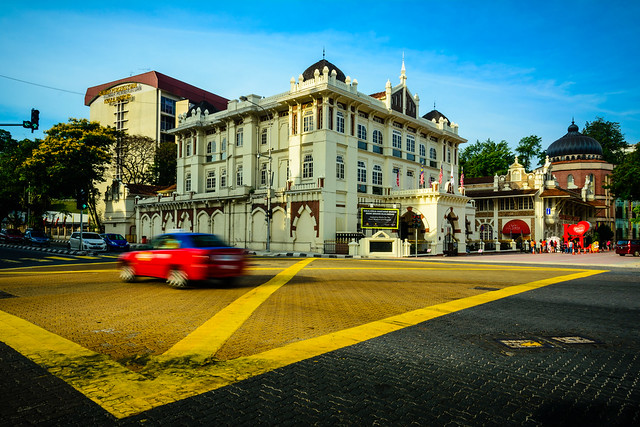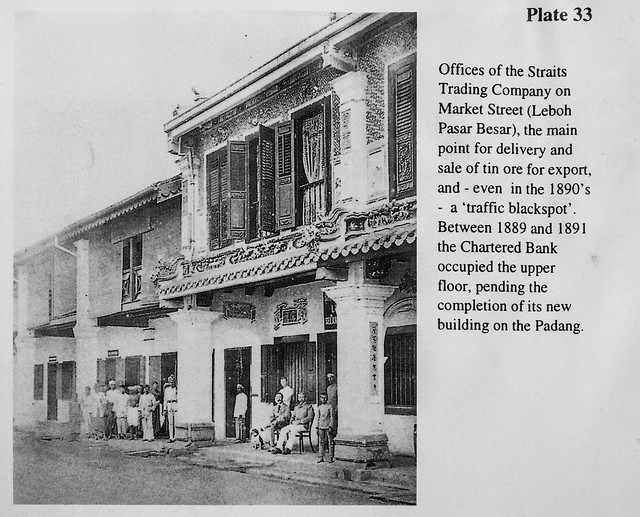 |
| The former building of then Chartered Bank of Australia, India and China |
For the British Colonial Government, after colonising a place - a state or a country, it was followed by exercising capitalism to ensure that they did not only impose administrative dominance but also economic hegemony by manipulating the rich resources available in Malaya at that time i.e. tin and rubber.
In making sure the economic viabilities were utilised to its fullest, it was necessary to provide lending facilities as part of the commitment to investments and to reap better yields from the harvest.
In 1880's the economic activities in Kuala Lumpur started getting active and vibrant, more so after the British Government relocated the Selangor administrative capital from Klang to Kuala Lumpur in 1880. However the trading activities were rather inconvenient at that time for a lack of bank notes. Money then was in the form of dollar coins and it was cumbersome especially when a high value transaction was involved.
According to JM Gullick in his book "A history of Kuala Lumpur 1856 - 1939" less bulky and more convenient were bank notes, issued by exchange banks in Singapore and elsewhere, but these were regarded with some distrust. It was more than a want of a convenient form of currency. In 1885, the (British) Resident had lamented that:
"The want of banking facilities is severely felt by all classes of community. Native traders and miners find it difficult to obtain cash advance in the Colony (Straits Settlement) however valuable may be the houses or other property in Selangor which they can offer as security, and they are consequently unable to purchase their goods in the best markets and at the cheapest rates but are practically in the hands of a few Chinese and Malay traders in Singapore and Malacca, who supply them with provisions in exchange for consignment of tin".
 |
The first premises occupied by Chartered Bank of India, Australia and China from 1888 to 1891 on the upper floor of shophouses located on Market Street (now Lebuh Pasar Besar) belonging to Straits Trading Company. (Image is reproduced from A history of Kuala Lumpur 1856-1939 book, used without permission but in accordance with the principle of fair use).
|
 |
The first building that housed Chartered Bank of India, Australia and China since 1891 sat on the same site the current building is now situated. (Old postcard)
|
After negotiations on these matters, the Chartered Bank of India, Australia and China opened a branch in Kuala Lumpur in 1888. It was first housed temporarily on the upper floor of shophouses on Market Street (now Lebuh Pasar Besar). The shophouses belonged to Straits Trading Company (even until now although it has been reconstructed) before the bank was later relocated to its own premises in 1891 on the south part of the Padang (now Dataran Merdeka or Independence Square). The current site was said to be chosen for security considerations as it was close to the police headquarters on Bluff Road (now Bukit Aman).
NEWLY BUILT STRUCTURE
 |
| The newly built edifice that housed Chartered Bank of India, Australia and China from 1909 sitting on the same site occupied by the previous building. |
Due to a fast growing business of Chartered Bank, the current single-storey building proved inadequate to meet its daily banking operations. A new and bigger building needed to be erected to cater for the bigger operations. As a result an elegant Mughal-inspired building was constructed on the same site. The Straits Times dated 28 August 1909 reported that "The new buildings of the Chartered Bank at Kuala Lumpur are making progress, and the interiors of the first and second storeys are nearly completed."
Meanwhile The Straits Times dated 29 November 1909 reported as follows:
"The new premises of the Chartered Bank at Kuala Lumpur are now practically complete, and the general opinion is that they are in every way an ornament to the town".
This handsome building was officially opened on 27 December 1909, only four days after the official opening of the
Jamek Mosque nearby across the Gombak River.
JM Gullick wrote that although the Chartered Bank building was opened with rather less pomp than the Jamek Mosque opening ceremony, there was no lack of speechifying and the Chartered Bank gave an "At Home" to inaugurate its new office, a reconstruction of the original building completed in 1891. Among other attractions, guests were taken to study 'the beauties of the strong room and its anti-burglar alarms'. To make it more compatible with the adjacent Sultan Abdul Samad Building and other neighbouring government buildings, built to face on to the Padang since 1891, an entrance porch and arches had been added to the frontal aspect.
This heritage building was designed in Mughal-eclectic architectural style to blend in with the other Mughal-eclectic style (also written Mogul, but often incorrectly referred to as Moorish) buildings in the surrounding area. Although in various tourism pamphlets or even books the architecture of this building is attributed to AC Norman (A Government Architect in PWD from 1890 to 1903), there is actually no official or valid record so far that confirms or shows this building was designed by AC Norman. In fact according to JM Gullick in his journal entitled The Bangunan Sultan Abdul Samad, AC Norman was compulsorily retired in 1903 at the age of 45 on well-documented grounds of inefficiency. This resulted from Norman's unsuccessful attempts in applying for promotion in 1899 and 1901.
To be honest there is a lot of misinformation on tourism pamphlet issued by Tourism Malaysia but that is reserved for another blog entry.
So it was impossible that Norman designed the building when he was retired in 1903 and went back to England soon after. Apart from that Norman was a government architect working for Selangor PWD and later Federated Malay States (FMS) PWD as the State Architect whose job was to design government buildings while this building owned by Chartered Bank was entirely a private project.
In addition, AC Norman was never known as an architect who designed a building featuring Mughal-inspired style. The Mughal style was first introduced by CE Spooner, the Selangor State Engineer, when designing The Sultan Abdul Samad Building while the technical drawings were produced by RAJ Bidwell under Spooner's guidance.
In my personal opinion, I strongly suspect that the architect must have come from any of the established architectural firms in Singapore such as Booty, Edwards & Partners or Swan & McLaren etc.
 |
The east wing that had its porch demolished to make way for the expansion of Jalan Sultan Hishamuddin
|
This building was originally symmetrical as it had a single-storey wing on both sides. However the east wing which extended onto Jalan Sultan Hishamuddin (formerly Victory Avenue) had to be removed when Jalan Sultan Hishamuddin was widened. In its place, arches were installed there to embellish the blank wall. There were also verandahs that are today enclosed with windows.
 |
Dome and protruding eaves are the typical features of Mughal architecture
|
Typical of Mughal architecture, domes are among its prominent features. There are four domes on the roof of this building placed at its four corners. The domes were constructed of belian wood, the tropical hard timber which can normally be found in Sarawak forest. Besides domes there are also pointed horseshoe arches forming the extended entrance to the building as well as the window frames on the ground floor. While the other top half of the facade’s window utilised a slight scalloped window frame as part of the opening to the structure to infuse the Mughal architecture style.
 |
| A 1926 photograph showing people streaming into the Chartered Bank building which was inundated by floods and the still standing single storey side structure. (Image is reproduced from the New Straits Times, without permission but in accordance with the principle of fair use) |
This building has recorded several notable historical events. The great flood of 1926 caused the bank’s vaults to be inundated. Business continued as usual upstairs in the living quarters, while staff had to be ferried by sampan. Millions of dollars of wet bank notes were laid out on the Padang (now Merdeka Square) in front to dry and guarded by the armed guards. Meanwhile, during Japanese occupation this building was used by Japanese Telecommunication Department. After the World War II was over, the function of the building as the main commercial bank was revived and it lasted until 1965 when The Chartered Bank was relocated to its new and bigger premises on Jalan Ampang.
The building was later occupied by the Kuala Lumpur District and Land Office which is now known as the Federal Territory Department of Land and Mines before it was taken over by the Federal Territory Religious Affairs Office. On the 24th October 1991 this building was officially handed over to the Department of Museum and Antiquities to be turned into the National History Museum. In November 2007 the National History Museum was closed down and its entire collection was permanently transferred to the National Museum.
This majestic edifice was once occupied by an upmarket restaurant after being vacated by the National History Museum but operating a restaurant from this classic building which has become a national treasure doesn’t do justice to its ‘status’. It once hosted the Music Museum only for a while and now it seems left vacant.
This building was gazetted a national heritage building in 2005.

REFERENCES
Building with rich history withstood two major floods. (2017, May 8). The Star. Retrieved from https://www.thestar.com.my/metro/community/2017/05/08/building-with-rich-history-withstood-two-major-floods
Chin, K.Y., & Chen, V.F. (1998). Kuala Lumpur, a sketchbook. Singapore: Archipelago Press.
Gullick, J.M. (2000). A history of Kuala Lumpur 1856-1939. Kuala Lumpur: MBRAS
Gullick, J. M. (1992). The Bangunan Sultan Abdul Samad. Journal of the Malaysian Branch of the Royal Asiatic Society, 65(1 (262)), 27-38. Retrieved May 8, 2020, from www.jstor.org/stable/41493197
KL's iconic landmarks. (2019, February 2). New Straits Times. Retrieved from https://www.nst.com.my/lifestyle/pulse/2019/02/456711/kls-iconic-landmarks
Untitled. (1909, August 28). The Straits Times. P6. Retrieved from https://eresources.nlb.gov.sg/newspapers/
Untitled. (1909, November 29). The Straits Times. P6. Retrieved from https://eresources.nlb.gov.sg/newspapers/








Hi, may I know do you have the floor plan of old chartered bank?
ReplyDeleteHi there. Thank you for dropping by. Unfortunately No. I don't have the floor plan of the building
DeleteHi Zain, thank you for sharing such an inspiring read. I was there today 23-Dec-2023 and it's sad to see that the building looks like it's been neglected. Grass is overgrown and it's beginning to look derelict.
ReplyDeleteTruly hope that a sensible authority can properly honour this 104 year old building..
Hi there,
DeleteThank you for visiting my blog. The building last served as the Music Museum if I am not mistaken before it moved to the National Museum about 7 or 8 years ago. Now, yes, sadly it seems abandoned but I believe it has been taken over by the Kuala Lumpur City Hall. Besides this building there are many other heritage buildings which are left to rot along the perimeter of the Merdeka Square. I have also blogged about some of them.
They were all built in the early 20th century when Malaya was the darling among the British colonies during which Malaya experienced tin and rubber boom.